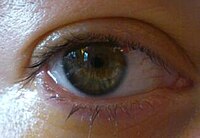
Photo from wikipedia
This study compared corneal thickness (CT) changes obtained with specular microscopy (SM) and a rotating Scheimpflug camera (RSC) after conventional phacoemulsification surgery (PS). One hundred sixty six eyes of 83… Click to show full abstract
This study compared corneal thickness (CT) changes obtained with specular microscopy (SM) and a rotating Scheimpflug camera (RSC) after conventional phacoemulsification surgery (PS). One hundred sixty six eyes of 83 patients were analyzed before and one month after PS. One eye underwent PS, while the fellow phakic one was used as control. CT was measured with SM at the center of the cornea and with RSC at the pupil center, at the corneal apex and at the thinnest point. In the operated eye, SM showed a larger CT mean increase than those one detected at the three different measurements’ points evaluated by RSC. Inversely, in the fellow phakic eye, SM showed a greater CT mean decrease than those one registered by RSC at its three measurement’s points. Thus, one month after surgery, even if cornea appears clear at the slit-lamp, a significant thickness increase is still present. This is even more evident if the slight decrease of the fellow phakic eye is considered. The differences between the two devices are probably related to the different measured areas.
Journal Title: Scientific Reports
Year Published: 2021
Link to full text (if available)
Share on Social Media: Sign Up to like & get
recommendations!